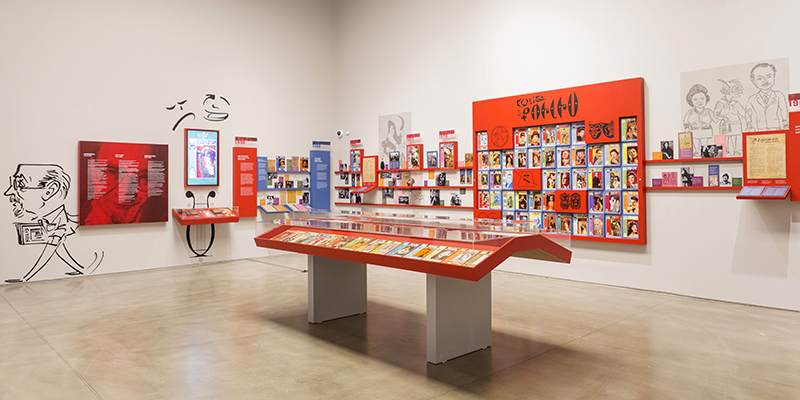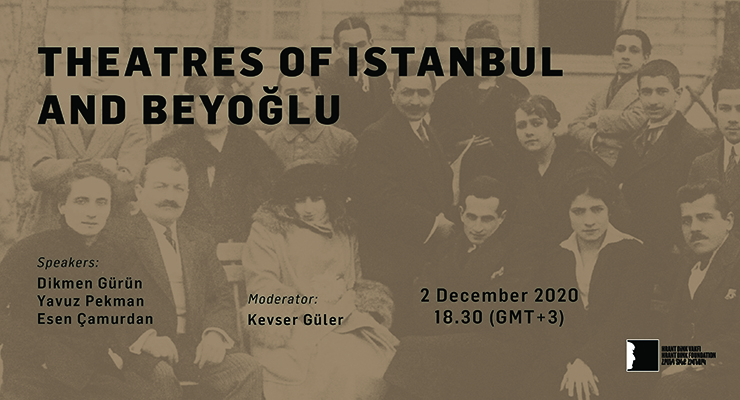The exhibition has been brought to life by the guidance of Hrant Dink Foundation with the collaboration of the Theatre Foundation of Turkey and Yapı Kredi Culture, Arts and Publishing.
You can visit the exhibition every weekday between 11.00-19.00 at Yapı Kredi Kültür Sanat. You can also have an online tour of the exhibition:
Contact for the press: Zeynep Sungur, This email address is being protected from spambots. You need JavaScript enabled to view it.
Who is Hagop Ayvaz?
 Hagop Ayvaz was born in Yenikapı, Istanbul in 1911. He debuted on stage in 1928 at the Narlıkapı Şafak Theater as an extra in the operetta Jaghatsbanin Aghchige [The Miller’s Daughter]. His first lead role was in the The Trail of the Serpent at the Beyoğlu Yenişehir Garden Theater in 1930. He wrote about theater at periodicals like Jamanag, Turkiya, Gavroş, Nor Or between 1935–1946. Together with Zareh Arşag and Nazaret Donikyan, he co-founded the Kulis magazine in 1946. Between 1947–1950, he organized special nights for Kulis where Armenian and Turkish artists shared the same stage. After 1948, he started traveling abroad for Kulis and reached more readers and writers in many countries of the Middle East as well as Armenia and Greece. Between 1954–1956, he published Kulis in Turkish with the support of the Istanbul Operetta Association. He assumed the leadership of the Stage Troupe of the Esayan School Alumni Association in 1960 and made his directorial debut with Galip Arcan’s Rica Ederim Kesmeyiniz [Please Do Not Interrupt] and founded Pokr Taderhump [Small Company]. He started writing for his memorable column Lutsika Dudu [Mrs. Lutsika] in 1968. In 1996 he published the last issue of his five- decade-old magazine Kulis, which received countless awards in Turkey and abroad and started writing for Agos in 1997, which lasted until 2006. He received the 1997 Press Service Award of the Writers Union of Turkey and 2005 Honorary Award of the Theater Critics Association of Turkey. He died on September 29, 2006 and was buried at the Şişli Armenian Cemetery.
Hagop Ayvaz was born in Yenikapı, Istanbul in 1911. He debuted on stage in 1928 at the Narlıkapı Şafak Theater as an extra in the operetta Jaghatsbanin Aghchige [The Miller’s Daughter]. His first lead role was in the The Trail of the Serpent at the Beyoğlu Yenişehir Garden Theater in 1930. He wrote about theater at periodicals like Jamanag, Turkiya, Gavroş, Nor Or between 1935–1946. Together with Zareh Arşag and Nazaret Donikyan, he co-founded the Kulis magazine in 1946. Between 1947–1950, he organized special nights for Kulis where Armenian and Turkish artists shared the same stage. After 1948, he started traveling abroad for Kulis and reached more readers and writers in many countries of the Middle East as well as Armenia and Greece. Between 1954–1956, he published Kulis in Turkish with the support of the Istanbul Operetta Association. He assumed the leadership of the Stage Troupe of the Esayan School Alumni Association in 1960 and made his directorial debut with Galip Arcan’s Rica Ederim Kesmeyiniz [Please Do Not Interrupt] and founded Pokr Taderhump [Small Company]. He started writing for his memorable column Lutsika Dudu [Mrs. Lutsika] in 1968. In 1996 he published the last issue of his five- decade-old magazine Kulis, which received countless awards in Turkey and abroad and started writing for Agos in 1997, which lasted until 2006. He received the 1997 Press Service Award of the Writers Union of Turkey and 2005 Honorary Award of the Theater Critics Association of Turkey. He died on September 29, 2006 and was buried at the Şişli Armenian Cemetery.What is Hagop Ayvaz’s archive composed of?
 Armenian theater player, director, author and publisher, theatre lover Hagop Ayvaz’s archive encompasses a period of 150 years from the first years of theatre in the Ottoman Empire starting from mid-19th century until the beginning of 21st century. While shedding light on the history of Ottoman-Turkish theater, this archive also contributes greatly to the collective memory. The archive, donated to the Agos newspaper after Ayvaz’s death in 2006, consists of around 300 theatrical play manuscripts in Ottoman, Armenian and Turkish, more than 300 printed texts of plays in three languages, more than 500 periodicals, magazines and brochures in Armenian and Turkish, around 12,000 photographs, posters, cartoons, newspaper and magazine clips, invitations, drawings and postcards. The archive had achieved a more coherent and whole structure after the donation in 2019 to the Hrant Dink Foundation of some of Ayvaz’s personal effects, awards, a 1104-issue full collection of his culture and arts magazine ‘Kulis’ published uninterruptedly from 1946 till 1996 in Armenian. Over the years, Hrant Dink Foundation created a catalogue for the archive and digitalized it, and this online archive was opened to researchers simultaneously with the openning of the “Coulisse: Hagop Ayvaz, A Chronicler of Theater” exhibition on December 15, 2020.
Armenian theater player, director, author and publisher, theatre lover Hagop Ayvaz’s archive encompasses a period of 150 years from the first years of theatre in the Ottoman Empire starting from mid-19th century until the beginning of 21st century. While shedding light on the history of Ottoman-Turkish theater, this archive also contributes greatly to the collective memory. The archive, donated to the Agos newspaper after Ayvaz’s death in 2006, consists of around 300 theatrical play manuscripts in Ottoman, Armenian and Turkish, more than 300 printed texts of plays in three languages, more than 500 periodicals, magazines and brochures in Armenian and Turkish, around 12,000 photographs, posters, cartoons, newspaper and magazine clips, invitations, drawings and postcards. The archive had achieved a more coherent and whole structure after the donation in 2019 to the Hrant Dink Foundation of some of Ayvaz’s personal effects, awards, a 1104-issue full collection of his culture and arts magazine ‘Kulis’ published uninterruptedly from 1946 till 1996 in Armenian. Over the years, Hrant Dink Foundation created a catalogue for the archive and digitalized it, and this online archive was opened to researchers simultaneously with the openning of the “Coulisse: Hagop Ayvaz, A Chronicler of Theater” exhibition on December 15, 2020.



![]()




